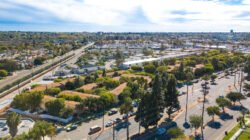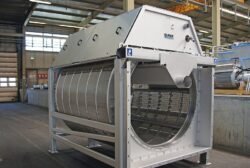Dallas Southside Wastewater Treatment Plant

As the world faces increasing environmental challenges, urban centers like Dallas, Texas, are at the forefront of developing innovative solutions for wastewater management. The Dallas Southside Wastewater Treatment Plant exemplifies these efforts by providing essential sanitation services while prioritizing sustainability, technology, and community engagement. In this comprehensive article, we explore the history, technological advancements, environmental impact, and future prospects of the Dallas Southside Wastewater Treatment Plant, highlighting its critical role in urban sustainability.
Historical Context
Early Sanitation Efforts in Dallas
The origins of Dallas’s wastewater management systems date back to the early 20th century when the burgeoning city faced significant public health challenges. With the population rapidly expanding, sanitation became a pressing issue. The establishment of initial sewer systems marked the beginning of organized wastewater management efforts. However, these early systems were rudimentary, with untreated wastewater often discharged directly into nearby rivers, contributing to pollution and health hazards.
Establishment of the Southside Wastewater Treatment Plant
The Southside Wastewater Treatment Plant was inaugurated in 1959, addressing the urgent need for a dedicated facility to treat sewage and ensure public health. Strategically located on the southern outskirts of Dallas, the plant was designed to handle the increasing wastewater output from the city’s growing population.
Evolution and Upgrades
Over the decades, the plant underwent numerous upgrades to enhance its capacity and efficiency. Technological advancements in wastewater treatment processes were integrated, transforming the facility into a state-of-the-art entity capable of meeting the city’s evolving needs.
Technological Advancements
Primary Treatment Process
The primary treatment process at the Dallas Southside Wastewater Treatment Plant involves removing large solids and organic materials from incoming sewage. This is achieved through screening, grit removal, and sedimentation. Advanced screening technologies, such as fine screens and mechanical bar screens, ensure efficient separation of debris, preventing blockages and damage to downstream equipment.
Screening and Grit Removal
Upon arrival, wastewater passes through screens to remove larger debris like plastics, rags, and other non-biodegradable materials. Following this, grit chambers extract heavier inorganic particles such as sand and gravel. These initial steps are crucial for safeguarding subsequent treatment processes from potential mechanical disruptions.
Sedimentation Tanks
Sedimentation tanks allow suspended solids to settle, forming sludge at the bottom. This sludge is then collected for further treatment, while the clarified water proceeds to the next stage. Sedimentation significantly reduces the organic load, making the subsequent biological treatment more efficient.
Secondary Treatment Process
The heart of the plant’s operations lies in the secondary treatment process, which focuses on the biological degradation of organic pollutants. Activated sludge processes are employed, wherein microorganisms break down organic matter, converting it into solids that can be easily separated from the treated water.
Activated Sludge Process
In aeration tanks, wastewater is mixed with a carefully controlled microbial community. Oxygen is supplied to stimulate the activity of bacteria, protozoa, and other microorganisms that consume organic pollutants. The result is the formation of floc, which consists of aggregated microorganisms and organic matter.
Secondary Clarifiers
Secondary clarifiers allow the separation of the biological floc from the treated water. The settled biomass, known as activated sludge, is either returned to the aeration tank to maintain the microbial population or directed to sludge treatment processes.
Tertiary Treatment and Advanced Processes
To achieve high-quality effluent standards, the plant incorporates tertiary treatment, which includes advanced filtration, disinfection, and nutrient removal processes. These steps ensure the final effluent is safe for discharge into water bodies or for reuse in various applications.
Filtration and Disinfection
Filtration involves passing the treated water through sand or membrane filters to remove fine particles and pathogens. The filtered water is then disinfected using methods such as chlorination, ultraviolet (UV) irradiation, or ozonation. These processes effectively eliminate harmful microorganisms, ensuring the effluent is safe for release into the environment.
Nutrient Removal
To combat eutrophication and protect aquatic ecosystems, the plant employs nutrient removal processes to reduce nitrogen and phosphorus levels in the effluent. Biological nutrient removal (BNR) techniques, such as nitrification-denitrification and biological phosphorus removal, are integrated to achieve this.
Sludge Management and Resource Recovery
The Dallas Southside Wastewater Treatment Plant places significant emphasis on sludge management and resource recovery, aligning with principles of circular economy and sustainable practices.
Sludge Treatment
The collected sludge undergoes various treatment processes to reduce volume, stabilize organic matter, and minimize pathogens. Anaerobic digestion, where microorganisms break down organic material in the absence of oxygen, is commonly used. This process produces biogas, a valuable renewable energy source.
Biogas Production and Energy Recovery
The captured biogas, primarily composed of methane, is harnessed for energy production. Combined heat and power (CHP) systems convert biogas into electricity and thermal energy, which can be used to power plant operations or fed into the local grid. This not only reduces the plant’s carbon footprint but also contributes to the local energy supply.
Biosolids Utilization
Stabilized biosolids, the byproduct of sludge treatment, are rich in nutrients and organic matter. These can be processed further to produce fertilizers, soil conditioners, or used in land reclamation projects. The plant’s comprehensive approach to sludge management ensures that valuable resources are recovered and utilized sustainably.
Environmental Impact
Water Quality and Ecosystem Protection
The primary objective of the Dallas Southside Wastewater Treatment Plant is to safeguard water quality and protect surrounding ecosystems. By treating wastewater to stringent standards, the plant prevents harmful pollutants from entering rivers, lakes, and other water bodies.
Effluent Quality Standards
The plant adheres to strict effluent quality standards set by regulatory authorities, ensuring that discharged water meets or exceeds environmental guidelines. Regular monitoring and testing are conducted to assess parameters such as biochemical oxygen demand (BOD), total suspended solids (TSS), nutrient levels, and pathogen counts.
Enhanced Water Reuse
Recognizing the importance of conserving water resources, the plant actively promotes water reuse initiatives. Treated effluent can be repurposed for non-potable applications such as irrigation, industrial processes, and recreational use. Implementing water reuse projects reduces the demand on freshwater sources and contributes to overall water sustainability.
Community Engagement and Education
Public Outreach Programs
The Dallas Southside Wastewater Treatment Plant recognizes the importance of community engagement and education in fostering environmental awareness. The plant regularly conducts public outreach programs to inform residents about wastewater treatment processes, water conservation, and sustainable practices.
Facility Tours and Workshops
Facility tours and educational workshops provide valuable insights into the plant’s operations and the science behind wastewater treatment. These initiatives aim to demystify the treatment process, encouraging responsible water use and waste disposal practices among the community.
Collaborations with Educational Institutions
Collaborating with local schools, colleges, and universities, the plant offers educational programs that cater to students of all ages. These programs often include interactive sessions, laboratory demonstrations, and hands-on activities, fostering a deeper understanding of environmental stewardship.
Community Feedback and Continuous Improvement
The plant values community feedback and actively seeks input from residents, environmental organizations, and other stakeholders. This feedback is instrumental in identifying areas for improvement, addressing concerns, and enhancing the plant’s overall performance.
Future Prospects and Innovations
Embracing Cutting-Edge Technologies
As urban centers continue to grow, so does the need for innovative solutions in wastewater management. The Dallas Southside Wastewater Treatment Plant is committed to exploring and implementing cutting-edge technologies to enhance efficiency, sustainability, and resilience.
Smart Infrastructure and Automation
Integrating smart infrastructure and automation technologies allows for real-time monitoring and control of treatment processes. Sensors, data analytics, and artificial intelligence (AI) systems optimize operations, enabling proactive maintenance, efficient resource allocation, and rapid response to anomalies.
Membrane Bioreactors (MBRs)
Membrane bioreactors (MBRs) represent a significant advancement in wastewater treatment. These systems combine biological treatment with membrane filtration, providing superior effluent quality and allowing for water reuse in more demanding applications. The plant is actively exploring the feasibility and benefits of incorporating MBR technology.
Climate Resilience and Adaptation
Climate change poses new challenges for wastewater treatment plants, including increased rainfall, flooding, and temperature variations. The Dallas Southside Wastewater Treatment Plant is dedicated to enhancing climate resilience through adaptive strategies.
Infrastructure Upgrades
Infrastructure upgrades, such as flood protection measures and stormwater management systems, help mitigate the impact of extreme weather events. Reinforcing treatment processes to handle variable influent conditions ensures consistent performance even in the face of climate-related challenges.
Sustainable Energy Solutions
Expanding the utilization of renewable energy sources remains a priority for the plant. In addition to biogas production, the plant explores options for incorporating solar panels, wind turbines, and other sustainable energy technologies. Achieving energy neutrality or even becoming a net energy producer contributes to the plant’s overall sustainability.
Conclusion
The Dallas Southside Wastewater Treatment Plant stands as a testament to the city’s commitment to urban sustainability, environmental protection, and community engagement. Through continuous technological advancements, resource recovery initiatives, and educational outreach, the plant exemplifies a holistic approach to wastewater management. As Dallas and other urban centers face evolving environmental challenges, the plant’s dedication to innovation and sustainability serves as a model for future wastewater treatment efforts.
Embodying the principles of circular economy and resilience, the Dallas Southside Wastewater Treatment Plant is more than a facility—it is a cornerstone of a sustainable urban ecosystem that prioritizes both public health and environmental stewardship. By valuing the interconnectedness between technology, community, and the environment, the plant holds its promise to contribute to a greener, more sustainable future for Dallas and beyond.



